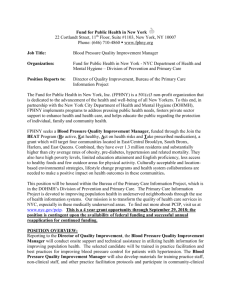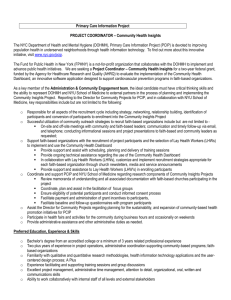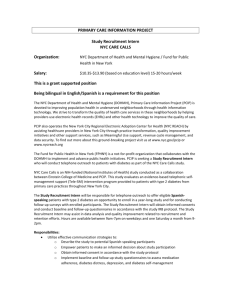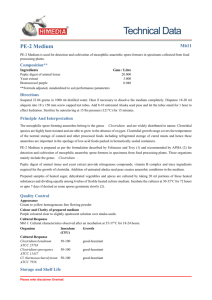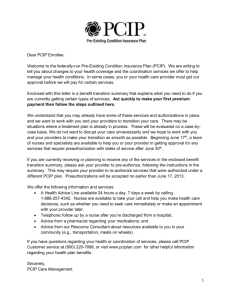Document 11583312
advertisement
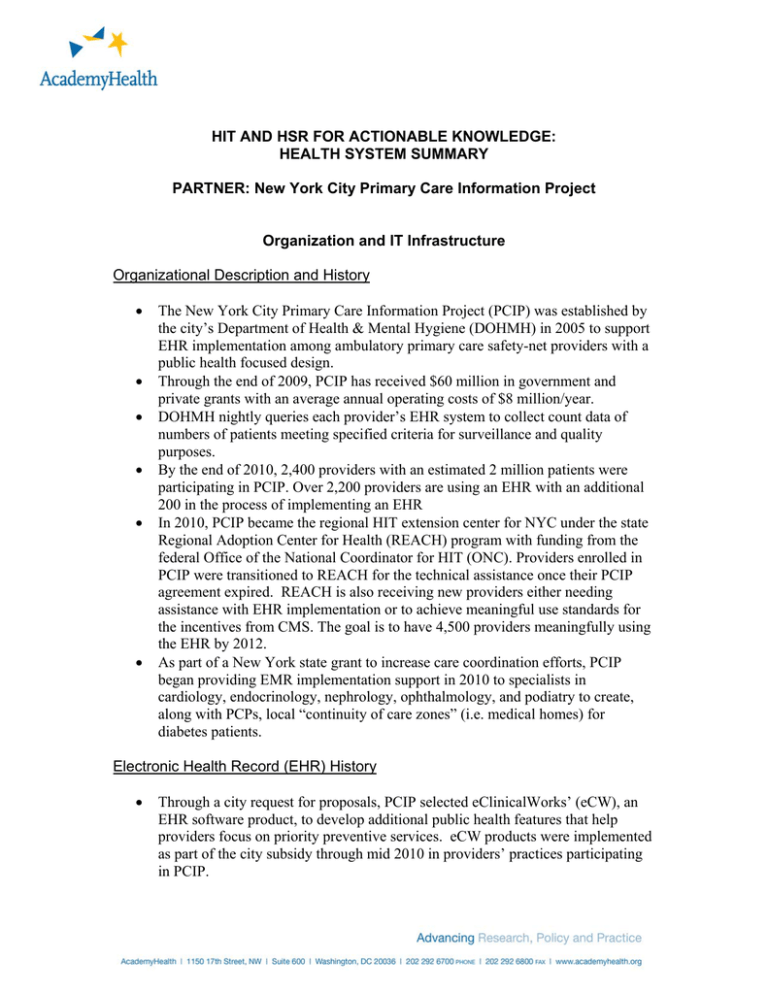
HIT AND HSR FOR ACTIONABLE KNOWLEDGE: HEALTH SYSTEM SUMMARY PARTNER: New York City Primary Care Information Project Organization and IT Infrastructure Organizational Description and History The New York City Primary Care Information Project (PCIP) was established by the city’s Department of Health & Mental Hygiene (DOHMH) in 2005 to support EHR implementation among ambulatory primary care safety-net providers with a public health focused design. Through the end of 2009, PCIP has received $60 million in government and private grants with an average annual operating costs of $8 million/year. DOHMH nightly queries each provider’s EHR system to collect count data of numbers of patients meeting specified criteria for surveillance and quality purposes. By the end of 2010, 2,400 providers with an estimated 2 million patients were participating in PCIP. Over 2,200 providers are using an EHR with an additional 200 in the process of implementing an EHR In 2010, PCIP became the regional HIT extension center for NYC under the state Regional Adoption Center for Health (REACH) program with funding from the federal Office of the National Coordinator for HIT (ONC). Providers enrolled in PCIP were transitioned to REACH for the technical assistance once their PCIP agreement expired. REACH is also receiving new providers either needing assistance with EHR implementation or to achieve meaningful use standards for the incentives from CMS. The goal is to have 4,500 providers meaningfully using the EHR by 2012. As part of a New York state grant to increase care coordination efforts, PCIP began providing EMR implementation support in 2010 to specialists in cardiology, endocrinology, nephrology, ophthalmology, and podiatry to create, along with PCPs, local “continuity of care zones” (i.e. medical homes) for diabetes patients. Electronic Health Record (EHR) History Through a city request for proposals, PCIP selected eClinicalWorks’ (eCW), an EHR software product, to develop additional public health features that help providers focus on priority preventive services. eCW products were implemented as part of the city subsidy through mid 2010 in providers’ practices participating in PCIP. Through a request for application (RFA) process, NYC REACH selected EHR vendors for implementing and assisting practices to Meaningful Use. EHR vendors for EHR implementation supported by REACH include As part of REACH, in mid-2010 PCIP began providing implementation services for two additional systems (MDland.com’s iClinic, and Greenway Medical’s PrimeSuite) as well as post-implementation support for additional EMR systems developed by MedLink, and Nextgen. Additional EHR vendors will be considered in future requests for applications. Research Influence in EHR Design Public health analysts and quality of care specialists are involved in the customization of the eCW’s EHR functionality at the point of care. These features include: o Customizable order sets o Smart forms o Clinical decision support o Quality reporting tool o Searchable Registry PCIP also worked with various vendors to develop a distributed/federated data model for receiving information. The data are gathered for specific purposes, such as: o Syndromic surveillance o Provider and practice performance on key Take Care New York health care indicators 1 o Use of EHR to achieve Meaningful Use Data Management For eCW, depending on the service model, the provider’s EMR data remains at the practice’s office (client server, on-site) or at eCW’s servers (software as a service); patient records are not centralized. For multiple EHR vendors, aggregated (non-identified) count data is transmitted to DOHMH and maintained on in a DOHMH data ware house. Depending on the data source, some are transmitted nightly, others weekly or monthly. Data Available For Research 1 Types of aggregated, de-identified (“count”) data that are transmitted to DOHMH through EHR vendors for participating practices include: o Practice management data by CPT code and provider o Clinical information including effectiveness of care and syndromic surveillance measures For more information, visit: http://www.nyc.gov/html/doh/html/tcny/index.shtml 1 o Informatical data (e.g. statistics on EMR use) captured as part of an evaluation of the PCIP project itself. Other data sources are collected through PCIP’s programmatic operations or evaluation activities: o Practice demographics o Patient experiences o Provider experiences Participating providers have access to lists that helps identify patients that contributed to quality measurement reports. IT Support For Research PCIP has IT support in its own offices for public health and other analyses of aggregated, non-identifiable EMR data and to conduct queries of member practices’ EMR systems. The program provides separate IT support for implementation and use of EMR systems in physicians’ practices; this can include support for analyses of practices’ EMR data for quality and efficiency improvement purposes. Research Environment How Research is Organized PCIP and NYC REACH is directed by an Assistant Commissioner, who reports monthly to the Health Commissioner. Research and other analytic functions are distributed among PCIP’s several organizational units: o Personnel conducting surveillance and public health analysis reports to PCIP’s Executive Director of Development. (Staff report that this reflects the organization’s commitment to innovation in carrying out its public health responsibilities and in most fully leveraging the EHR technology.) o Executive Director of PCIP for the Healthcare Quality Information Network (HQIN) and Evaluation works collaboratively with the Executive Director of Development to collect quality measurement data tied to city health goals. Personnel conducting research evaluating programs developed by PCIP also reports to PCIP’s Executive Director of HQIN. Types of secondary/research uses of HIT data include: o Syndromic surveillance o Methodological research to extend syndromic surveillance capabilities o Other public health measurement o On site quality analysis done with individual providers’ panel EMR data. Other measurement and analysis to support small practice consultation (e.g. identification of patients in need of preventive care.) 2 o Merging data collected from PCIP to other sources (claims data or externally calculated quality measures) to evaluate the impact of the PCIP program. Research Culture PCIP maintains collaborative arrangements with faculty at local universities to help with its public health research and evaluations of PCIP. PCIP researchers and analysts often publish in peer-reviewed literature and share results at scientific meetings, especially in the field of public health and for work done collaboratively with academic researchers. Research Funding PCIP has supported research through existing resources that are a part of the program implementation activities as well as through collaborations with external researchers to obtain funding from AHRQ, CDC, and other private foundations. Data Stewardship The distributed network model employed by PCIP to store EHR data minimizes risk to patients and providers by limiting access to de-identified, aggregated (“count”) data. IRB approvals are sought whenever additional access to detailed practice or patient information is needed. The range of research questions and amount of data collected from each practice is limited by the distributed network as new programming and deployment of updated software is needed. In addition, access to all practices for new or patient level queries is limited by ability of PCIP to obtains specific permission, after obtaining IRB review and approval. Any analysis involving identified data (e.g. of a particular physician’s patient panel records) is subject to HIPAA and other privacy rules. Public health research and analysis involving human subjects (including evaluation projects of PCIP) are reviewed by the DOHMH’s IRB. Human subjects research conducted collaboratively with other institutions are reviewed by both organization’s IRB. For programmatic activities, such as quality improvement (QI) coaching conducted by PCIP-employed consultants regularly access patient and practice data on-site as part of the quality and efficiency improvements efforts. These activities are conducted outside of the purview of the IRB. Any activities beyond the standard QI curriculum require IRB review and approval. Organization of Quality-Related Functions at PCIP 3 PCIP’s utilizes the data warehouse - Healthcare Quality Information Network (HQIN) – to gather and generate quality reports on quality measures tied to NYC health goals (e.g. A1C, asthma, BMI, cholesterol, disease screening, vaccinations, smoking cessation). These data are shared back to individual practices and their providers for QI purposes or participation in pay-for-performance or provider recognition programs. As part of NYC REACH, the data from HQIN is also used to monitor the provider’s achievement of Meaningful Use standards. This is a feedback process to help assess provider progress to achieving goals. The data warehouse is also developing score cards that can be used by local and national payers to help pre-qualify practices as well as ease the reporting burden to federal or other payer requests. 4
